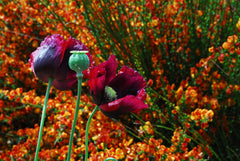The paper petals of poppy flowers will brighten up the spring garden. Poppies come in a wide range of colors and are easy to grow in sunny gardens. There are both perennial and annual poppy varieties but all are fairly easy to grow from seed. In fact poppies prefer to sown in the garden where they are to grow. Provide well drained soil and plenty of sunshine and you can have poppies blooming for months.
Breadbox Poppy- Papaver somniferum
Papaver somniferum, also known as Breadbox Poppy, is a very large flowered annual variety that grows 3-4 ft. tall. The seeds need light to germinate and can be broadcast directly onto prepared flower beds. The seeds will germinate in temperatures of 40-55 degrees. In areas zone 6 and warmer the seeds can be sown in the fall. Seeds must be kept moist to germinate. I have had some very dry autumns and have had low germination. Seeds can also be sprinkled out in the winter and seedlings will emerge when the temperatures are optimum. The foliage of this poppy is easy to recognize for the blue green frilled leaves. The very fine seeds tend to clump together so it will be necessary to thin seedlings to at least 6 inches apart. This will allow the foliage to form a large clump and produce larger flowers. The pods of this poppy can be left to dry in the garden. The seeds can be collected once the pods are fully browned. Give the pods a light shake and you will hear the dried seeds insides. The pods of this variety are excellent in dried crafts.
Shirley Poppies- Papaver rhoeas
Shirley Poppies are another great annual variety of poppies. The flowers are smaller than the Breadbox type but are just as pretty woven through flower beds. The Shirley Poppy is a smaller plant with blooming stems reaching up to 2 feet. The paper petals bloom in shades of pink, white, red, and a few bicolors. The foliage is a delicate green covered in soft hairs.Shirley Poppy seeds also need light to germinate and should be sown where they are to grow.
Oriental Poppies- Papaver orientale
The Oriental Poppy is a perennial poppy with extra large papery flowers. When grown from seed it will not begin blooming until the second year. Some gardeners find this type of poppy difficult to grow but if it planted in the right place it will bloom for years. Like all poppies, provide lots of sunlight and well drained soil. The foliage of this poppy goes dormant in the summer after it is finished blooming. During this dormant period the plant must be kept very dry. I have several long lived plants tucked in among large rocks in my flower beds. This serves as a reminder to me so I do not dig into the crowns during the dormant period. I garden on a well and none of my plants (other than veggies) get spoiled with additional water. The summers here tend to be very dry so this excellent for cultivating this type of poppy. My favorite Oriental Poppy has huge scarlet red blooms. In the mornings the flowers are literally vibrating from all of the bee activity. All of the poppies are excellent for attracting pollinators.
Poppies are rarely bothered by pests or disease. The only problem can arise if the spring is especially wet. I have had plants rot where they are standing. The deer leave most poppies alone. They seem to enjoy the Oriental Poppy mainly since it has pretty new green foliage in the winter when everything else is dormant. If warm weather arrives too quickly the plants will be less showy and go to seed more quickly. Poppies do reseed readily but not to the point of being a problem. I am always happy to see them weave themselves through established plantings. The seedlings are easy to recognize and pull if unwanted. I never have too many!





